Breathing Principles
Through scientific articles, books, classes, and my own experience, I have discovered three breathing principles for optimal blood sugars. These principles form the foundation of many breathing protocols used in the scientific literature. They are also used in many popular breathing techniques. However, I prefer principles over “techniques” because there are many different methods that fall within each principle. You choose which is right for you.
These principles should complement your current diabetes care plan. If you just got diabetes or have had poor control in the past, breathing is a great place to start. In The Power of Habit, Charles Duhigg describes what he calls “Keystone Habits”: habits that facilitate other good habits. I believe correct breathing is a keystone habit that forms the foundation of good health.
Correct breathing is a keystone habit that forms the foundation of good health.
Once you start noticing improvements in your blood sugars, energy, and well-being, you’ll be motivated to keep going. Of course, breathing alone will not fix everything, but it will make everything else easier!
1. Breathe Through Your nose
The nose warms and humidifies the incoming air, improves gas exchange in the lungs, naturally activates the diaphragm, and slows down your breathing rate to activate the parasympathetic nervous system
2. Breathe Slowly
Slow breathing is the quickest way to “flip the switch” and restore balance to your cardiovascular, autonomic, and respiratory systems. Slow breathing also helps with stress, anxiety, and panic attacks.
3. Hold your breath
Intermittent hypoxia training (IHT) can lower blood sugar independent of insulin. It also has been shown to improve insulin sensitivity, especially when it is paired with exercise. IHT also enhances immune function and reduces inflammation.



